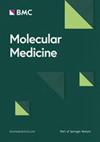Ferrostatin-1 ameliorates Cis-dichlorodiammineplatinum(II)-induced ovarian toxicity by inhibiting ferroptosis
IF 6
2区 医学
Q1 BIOCHEMISTRY & MOLECULAR BIOLOGY
引用次数: 0
Abstract
Cis-dichlorodiammineplatinum(II) (CDDP), while widely utilized in tumor therapy, results in toxic side effects that patients find intolerable. The specific mechanism by which CDDP inflicts ovarian damage remains unclear. This study aimed to explore the involvement of ferrostatin-1 (FER-1) and ferroptosis in CDDP-induced ovarian toxicity. This study established models of CDDP-induced injury in granulosa cells (GCs) and rat model of premature ovarian failure (POF). CCK-8 assessed the effects of CDDP and FER-1 on GC viability. FerroOrange and Mito-FerroGreen, DCFH-DA and MitoSox-Red, Rhodamine 123 and Transmission electron microscopy (TEM) measured Fe2+, reactive oxygen species (ROS), mitochondrial membrane potential and the mitochondrial morphology in GC cells, respectively. Serum hormone levels; organ indices; malondialdehyde, superoxide dismutase, and glutathione analyses; and western blotting were performed to examine ferroptosis's role in vitro. Molecular docking simulation was evaluated the interaction between FER-1 and GPX4 or FER-1 and NRF2. Molecular docking simulations were conducted to evaluate the interactions between FER-1 and GPX4, as well as FER-1 and NRF2. The findings revealed that CDDP-induced ovarian toxicity involved iron accumulation, increased ROS accumulation, and mitochondrial dysfunction, leading to endocrine disruption and tissue damage in rats. These changes correlated with NRF2, HO-1, and GPX4 levels. However, FER-1 decreased the extent of ferroptosis. Thus, ferroptosis appears to be a crucial mechanism of CDDP-induced ovarian injury, with GPX4 as potential protective targets.铁前列素-1通过抑制铁蛋白沉积改善顺式二氯二氨铂(II)诱导的卵巢毒性
顺式二氯二氨铂(II)(CDDP)虽然被广泛用于肿瘤治疗,但其毒副作用令患者难以忍受。CDDP造成卵巢损伤的具体机制仍不清楚。本研究旨在探究铁前列素-1(FER-1)和铁蛋白沉积在 CDDP 诱导的卵巢毒性中的参与作用。本研究建立了 CDDP 诱导的颗粒细胞(GCs)损伤模型和大鼠卵巢早衰(POF)模型。CCK-8 评估了 CDDP 和 FER-1 对粒细胞活力的影响。FerroOrange和Mito-FerroGreen、DCFH-DA和MitoSox-Red、Rhodamine 123和透射电子显微镜(TEM)分别测量了GC细胞中的Fe2+、活性氧(ROS)、线粒体膜电位和线粒体形态。血清激素水平、器官指数、丙二醛、超氧化物歧化酶和谷胱甘肽分析以及 Western 印迹技术也用于研究铁变态反应在体外的作用。分子对接模拟评估了 FER-1 与 GPX4 或 FER-1 与 NRF2 之间的相互作用。分子对接模拟评估了FER-1和GPX4以及FER-1和NRF2之间的相互作用。研究结果表明,CDDP诱导的卵巢毒性包括铁积累、ROS积累增加和线粒体功能障碍,从而导致大鼠内分泌紊乱和组织损伤。这些变化与 NRF2、HO-1 和 GPX4 水平相关。然而,FER-1 降低了铁变态反应的程度。因此,铁突变似乎是 CDDP 诱导的卵巢损伤的一个关键机制,而 GPX4 是潜在的保护靶点。
本文章由计算机程序翻译,如有差异,请以英文原文为准。
求助全文
约1分钟内获得全文
求助全文
来源期刊

Molecular Medicine
医学-生化与分子生物学
CiteScore
8.60
自引率
0.00%
发文量
137
审稿时长
1 months
期刊介绍:
Molecular Medicine is an open access journal that focuses on publishing recent findings related to disease pathogenesis at the molecular or physiological level. These insights can potentially contribute to the development of specific tools for disease diagnosis, treatment, or prevention. The journal considers manuscripts that present material pertinent to the genetic, molecular, or cellular underpinnings of critical physiological or disease processes. Submissions to Molecular Medicine are expected to elucidate the broader implications of the research findings for human disease and medicine in a manner that is accessible to a wide audience.
 求助内容:
求助内容: 应助结果提醒方式:
应助结果提醒方式:


